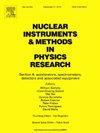Test of photomultiplier tubes for the Muon Detectors of the Large High Altitude Air Shower Observatory
IF 1.5
3区 物理与天体物理
Q3 INSTRUMENTS & INSTRUMENTATION
Nuclear Instruments & Methods in Physics Research Section A-accelerators Spectrometers Detectors and Associated Equipment
Pub Date : 2025-07-15
DOI:10.1016/j.nima.2025.170793
引用次数: 0
Abstract
Muon detectors make the Large High Altitude Air Shower Observatory (LHAASO) very efficient in distinguishing gamma-ray-induced extensive air showers from those induced by cosmic rays. A total of 1188 8-inch photomultiplier tubes (PMTs), CR365-02-2 from Beijing Hamamatsu Photon Techniques Inc. (BHP), are used for the Muon Detectors of LHAASO. These PMTs must have a high dynamic range, from single photoelectron to bunches of photoelectrons, with an equivalent anode peak current of up to 1600 mA. Before deployment, each PMT was tested in the laboratory to determine various parameters, including working voltage, single photoelectron spectrum, quantum efficiency, transit time spread, dark count rate, afterpulse rate, anode-to-dynode amplitude ratio, and linearity. In this paper, the PMT batch test system and the test results of 1,275 PMTs are presented. Of the 1275 PMTs tested, 162 (12.7%) failed to meet the specification requirements, primarily due to issues with the dynamic range.
大型高空空气阵雨天文台介子探测器光电倍增管的测试
μ子探测器使大型高空空气阵雨天文台(LHAASO)在区分伽玛射线引起的广泛空气阵雨和宇宙射线引起的空气阵雨方面非常有效。LHAASO的μ子探测器共使用了1188根8英寸光电倍增管(pmt),编号为CR365-02-2,来自北京滨松光子技术有限公司(BHP)。这些pmt必须具有高动态范围,从单个光电子到7×105光电子束,等效阳极峰值电流高达1600毫安。在部署之前,每个PMT都在实验室进行了测试,以确定各种参数,包括工作电压、单光电子谱、量子效率、传输时间扩展、暗计数率、后脉冲率、阳极-阳极振幅比和线性度。本文介绍了PMT批量测试系统及1275台PMT的测试结果。在测试的1275个pmt中,162个(12.7%)不符合规范要求,主要是由于动态范围的问题。
本文章由计算机程序翻译,如有差异,请以英文原文为准。
求助全文
约1分钟内获得全文
求助全文
来源期刊
CiteScore
3.20
自引率
21.40%
发文量
787
审稿时长
1 months
期刊介绍:
Section A of Nuclear Instruments and Methods in Physics Research publishes papers on design, manufacturing and performance of scientific instruments with an emphasis on large scale facilities. This includes the development of particle accelerators, ion sources, beam transport systems and target arrangements as well as the use of secondary phenomena such as synchrotron radiation and free electron lasers. It also includes all types of instrumentation for the detection and spectrometry of radiations from high energy processes and nuclear decays, as well as instrumentation for experiments at nuclear reactors. Specialized electronics for nuclear and other types of spectrometry as well as computerization of measurements and control systems in this area also find their place in the A section.
Theoretical as well as experimental papers are accepted.

 求助内容:
求助内容: 应助结果提醒方式:
应助结果提醒方式:


